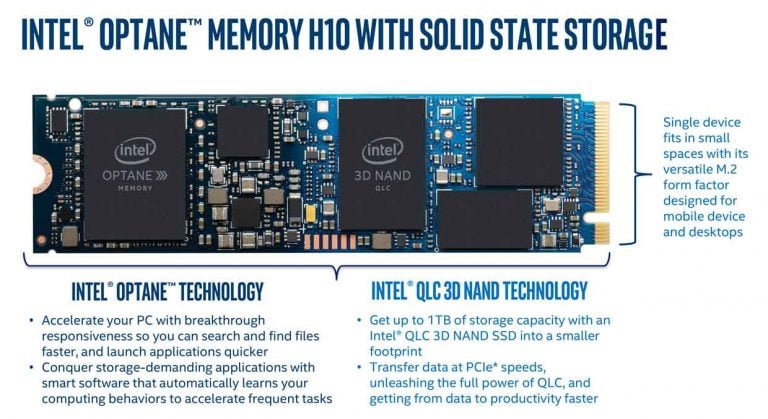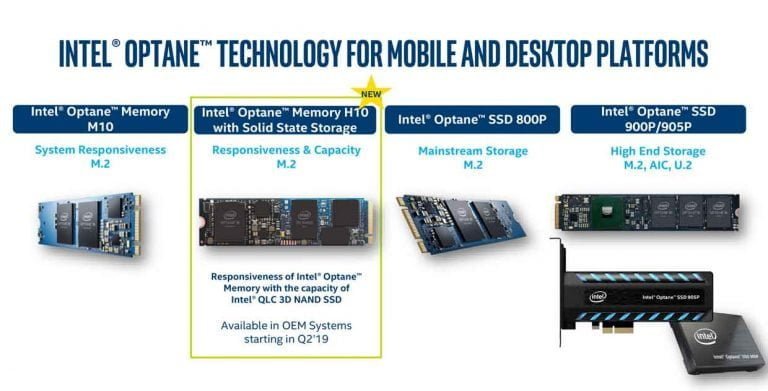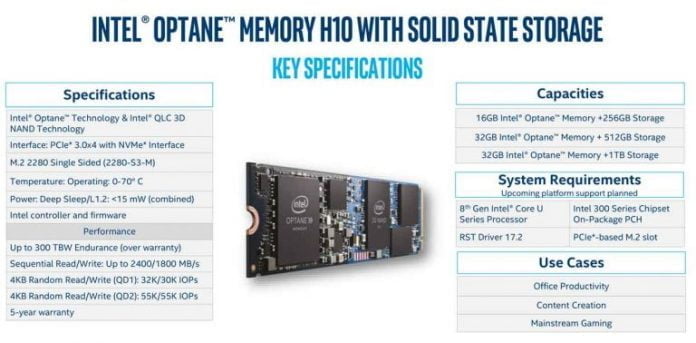Intel today announced more details about its combination of QLC 3D NAND SSD and Optane Cache on a 2280 M.2 motherboard. The M.2 module, as an Optane Memory H10 with solid-state storage, should combine the advantages of both memory technologies for notebooks.
By combining the best attributes of Intel Optane technology and Intel QLC 3D NAND Technology, the Intel Optane memory H10 with solid-state storage brings together two revolutionary memory and storage technologies on a single M.2 form factor. Delivering innovation in storage through Intel platforms, the Intel Optane memory H10 offers a personalized computing experience with a new level of performance and large storage capacity options, now available for gamers, media and content creators, everyday users, and professionals.
Here are the announced features of this new module according to its capabilities:
- 16GB Optane + 256GB SSD : 1450 MB / s (230,000 IOPS) read, 650 MB / s (150,000 IOPS) write, 75TB endurance of written data, 5.3W consumption
- 32GB Optane + 512GB SSD : 2300 MB / s (320,000 IOPS) read, 1300 MB / s (250,000 IOPS) write, 150 TB endurance of written data, 5.8W consumption
- 32GB Optane + 1 TB SSD : 2400 MB / s (330 000 IOPS) read, 1800 MB / s (250 000 IOPS) write, 300 TB endurance of written data, consumption 5.8W
Also Read: Google Pixel 3a is spotted at Google Play Console
The versatile M.2 form factor works in everything from thin and light notebooks to traditional desktops, as well as AIOs and mini PCs. Providing system responsiveness with storage capacities, the Intel® Optane™ memory H10 accelerates what you use most, from everyday tasks to managing large media and gaming files and applications.

The Intel Optane memory H10 offers low latency and high performance with mixed random read/write speeds at low queue depths, and under demanding workloads.
In addition, the Intel Optane memory H10 includes Intel QLC Technology with an aerial density advantage of 33% more1 bits per cell than the prior generation of Intel 3D NAND. That means large, reliable capacities in a small footprint.
Also Read: Meet the New Camera Champion, Huawei P30 Pro
With the intelligent Intel Rapid Storage Technology (Intel RST) driver working behind the scenes, Intel Optane™ memory H10 recognizes and remembers content needed for important and frequent tasks—quickly accelerates them for use—providing even faster access to your frequently used data.

These two types of memory require two controllers. So it is necessary to use the Rapid Storage application from Intel. RST will be in charge of distributing the data according to the uses. This technology is proprietary. It requires a motherboard equipped with an Intel 300 series chipset.
These SSDs are expected from the second quarter. They complete a range now quite complete with Optane Memory M10, Optane SSD 800P, 900P and 905P.





